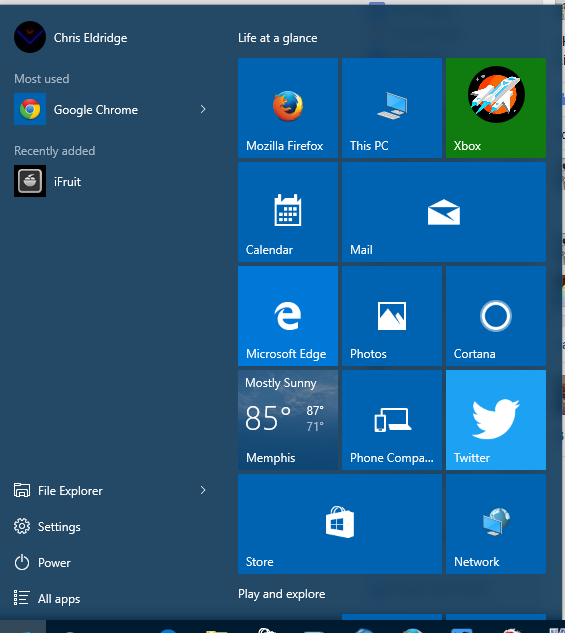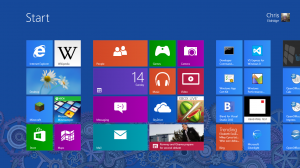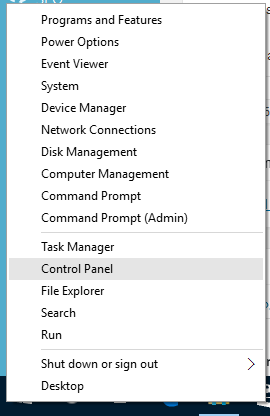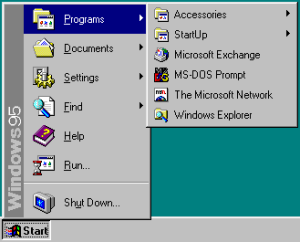The biggest aspect of Windows 10, the reason so many people have been awaiting its release, is the return of the Start Menu. Since Windows 95, back in August of 1995, PC users across the world have used that little menu for quick access to most everything on their computer, from running their favourite games to adjusting the system settings – The Start Menu is synonymous with Windows itself.

At the time of this article writing, my current Start Menu.
In 2012, Microsoft evolved the Start Menu into a new, fullscreen experience known as the Start Screen. To me, this was a wonderful addition that got to the point of what the Start Menu concept was – An easy way to start doing something with your machine. Having all the programs you use regularly in one nice, well laid out, customizable interface was perfect for me. For others, however, it was a terrible experience. While even I will agree, the Start Screen was jarring, and sudden to transition to, the basic idea was very solid. Instead of having to dig through folder after folder to find what you wanted to run, you had all your options lain out for you, and you could select what program you wanted to run with ease. I will never fully understand this criticism, but we are past that at this stage. I wrote more about this subject here.

The Start Screen.
With Windows 10, Microsoft has brought back the Start Menu that everyone loved so much.
Or did they?
Early on in using Windows 10, I noticed that the Start Menu, as it is in Windows 10, is basically a fusion of the common elements from the Windows 7 era Start Menu, the idea of a list of most commonly used apps, power options, and a variation of the classic “folder sorting” that the older Start Menu was known for, it also has, as its main user space, what can only be described as a condensed version of the Start Screen from Windows 8, pushed into a side panel. Live tiles and modern apps still provide real time information to you, with classic desktop programs having their own icons nicely presented in even little rows. I’ve quickly grown to love it, but even then, there are people who want the “classic” start menu back.
I can’t help but once again ask, why? Why would you want some archaic, slow folder sifting to find what you want to run, when you can just have the icon there, ready to go. What is the point? While yes, there are elements of the Windows 10 Start Menu that are different from the Windows 7 Start Menu, the options are still there. Indeed, some people complain about not being able to access the control panel from the Windows 10 Start Menu – this is silly, as control + x, or right clicking on start (options that were brought about in Windows 8, mind you), brings up a list of system options including the Control Panel, and you can also simply type in start “control panel” and get those options.

Control + X or Right Clicking on the Start button gives you this lovely power users menu.
Even better, just type the setting you want to change, and away it goes, to exactly what you wish to do with your machine.
I just don’t get it. People still refuse to learn how to operate the machines they seem to care so much for. It doesn’t take much time. I remember moving from Windows XP to Windows 7, and being confused as to where everything was, and how to change certain options. Now, ironically, going back to older XP machines, when I need to, is a confusing nightmare of illogical menu options and settings locations.
A little time spent learning something will always breed familiarity. Learning something new is something to be embraced, not shunned. It seems people want things to be released exactly how they want them to be, and if they have to learn something new, or do a tweak themselves, that’s far too much effort and thus it’s the product makers fault.
That to me is absolute idiocy.



I almost totally disagree with what you’re saying there! Why do WINDOWS does exist? What is its nature of existence? What is its mission? To make things plug & play, so reducing compatibilities issue and to make things easier to access and to use. So if you have to put on garbage most hardware and software you brought in the last 5 years, it mean that it failed in every aspect of its mission and against its own nature. Windows never was supposed to bring you new standard to use your tech, it’s not its job, that’s the job of developers to brough new limits so it the OS can adapt in newer version. The reality is that right now, Windows is gradually quitting the mainstream scence and a new OS war gonna be on nearby… So we’re entering in a new era because the new Microsoft is rejecting the idea behind Windows.
Please expand on your thoughts. I’m hearing generally positive responses to this release.
I’m also confused by your usage of the term “plug and play”, which refers to this technology: http://en.wikipedia.org/wiki/Plug_and_play which Windows 10 is fully compatible with.
Every operating system will have some software which is not going to be compatible with it – this is not as much a fault of the operating system (after all, it will have changes somewhere since if it is the same, then is it really new?), but the fault of the software and hardware makers for not updating to the new standard.
I’m quite confused by your comment, on a whole, but I am certain much is lost in translation!
“Please expand on your thoughts. I’m hearing generally positive responses to this release.”
Pretty much the reverse that i’m hearing almost everywhere we hear bad critics and people gets tips how to revert… Yes the first days it was a visibility success due the high amount of download. But people are really massive who are “downgrading” willfully to Windows 7, because Windows 10 seem like on a another planet or at least aiming a totally different customer base…
“I’m also confused by your usage of the term “plug and play”, which refers to this technology: http://en.wikipedia.org/wiki/Plug_and_play which Windows 10 is fully compatible with.”
Plug’n’Play since its debut, mean that you plug your hardware and the OS auto-detect it to make it work. Since Windows 8, it’s the main problem with the OS contrary to previous version who were accepting the use of previous version of drivers…
“Every operating system will have some software which is not going to be compatible with it – this is not as much a fault of the operating system (after all, it will have changes somewhere since if it is the same, then is it really new?), but the fault of the software and hardware makers for not updating to the new standard.”
You’re wrong, you’re missing the point; you see it in the wrong side. We are not talking about a OS developed for science, we’re talking about a OS developed for UTILITIES making easier to do. So as a TOOL! So this idea of windows since the first version is supposed to adapt itself to need of the industry. It is not its mission create new “approach”. It’s mission is to adapt new standard, not create new standard… And you’ll say: “Yes, but it’s ok! I love this!” Maybe it’s ok for you, but the cap change does mean that the original customers are currently in thinking to find a new OS (as they have to change 90% of their hardware) or stay with what they already are.
We must get to the fact, that the Windows who have been a worldwide success are those who were keeping the base clean as this a worktool not an entertainment thing… Windows 3, Windows 95, Windows 98SE, Windows XP, Windows 7… All the others failed to reach the mainstream audience because they were trying to reach new sky, when nobody was ready or asked for it…
And that’s my point, don’t call it Windows, if the idea is to go farther than the what it is suppose to be. I don’t say Windows 10 is a bad OS, i say Windows 10, shouldn’t be call Windows as it goes in a totally different direction. If they calling Windows, they shouldn’t ne surprise if masses refuse to go for it and think for alternative.
I don’t want to argue on this (I mean that politely) so I will try to summarize things here.
As I said, I am not seeing these people complaining about Windows 10 as you are. That doesn’t mean it isn’t happening, I just really am not seeing it. That being said, you mention these people are going back to Windows 7. That is telling, as to me, it seems these people simply refuse to accept change – they are the same people who did not like Windows 8, and stuck with 7 years ago. They naturally wouldn’t like 10 as well, since it is still something different and new.
These people, for whatever reason, refuse to move forward, and that’s fine for them – they do, however, hold us back on a whole from continued progress, much in the way Windows XP users held us back for several years on software taking full advantage of the elements of the newer Operating Systems.
On that note, again, beyond aesthetic elements, Windows is still Windows. It truly hasn’t changed much, at the core, since Windows Vista and 7. It IS the responsibility of software written for an operating system to take advantage of the operating systems features, not the OS to give in to the demands of older software.
New operating systems will contain (arguably) better ways to actually do the things the OS does, but it can, and should, support older software where possible. You don’t want to change everything, but you do want to advance where you can.
If software written for an older operating system does not want to work on the newer one, then it should be fixed to run on the new operating system. I have seen others make the same statement. Operating System legacy support can only go so far, and there are several older tools that I cannot run here on Windows 10 anymore. I’m okay with that, though, as I know it was inevitable that I would not be able to use them much longer. I will find a workaround using older operating systems in Virtual Machines.
The thing is, for most people, as in, average users, the things they do use are often simply games, a web browser or 2, or other things that are never so tied down to one OS, or often, are updated very regularly and thus never run into such major issues.
Things change. It’s that simple. I’m sorry that some people cannot accept that, but I do not feel that progress should be held back because people refuse to move on. Things can be fixed, but if people refuse to actually try out the new options, or get to know them, they are working from a flawed starting point, in my eyes.
That’s just how I feel on the subject. It’s the same year after year, advancement after advancement. Such is human nature.
We want new things, but we hate change. You can’t have both.
“I don’t want to argue on this (I mean that politely) so I will try to summarize things here.”
:^) It’s ok, anyway you know me, i’m not here to do a “fight”, i’m only trying to explain a point!
“We want new things, but we hate change. You can’t have both.”
That’s pretty much the point that i’m trying to debunk there because new things doesn’t mean change on what it is already existing!
Maybe I could say I look at the change as a way of streamlining things. You know, stuff gets more complex, then simple, then more complex again.
Options for users would be good. Pick the style you want. That would solve most user end problems – if you don’t like one way, use the other.
Standardization gets in the way, but that is its own argument. 😀